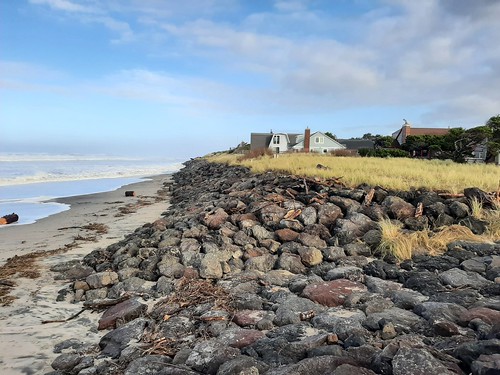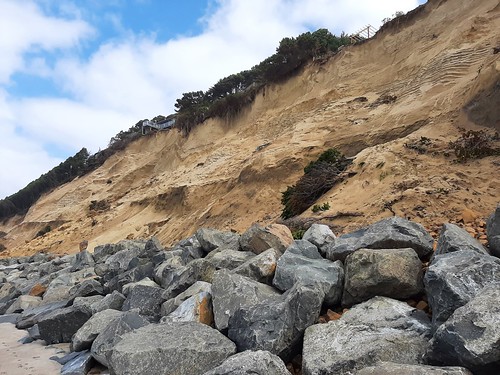As 2021 winds down, my fellowship is also coming to a close. It has been a wonderful and challenging experience. I wasn’t lucky enough to make it back into the office to meet coworkers in person this year, but I got to work with and learn from lots of awesome people virtually. My mentor, Meg Reed, is fantastic and was absolutely crucial in helping me succeed in this fellowship.
My main project for my fellowship was the creation of an erosion control guidebook. I spent the majority of the year reading, researching, and writing about erosion control and its regulation in Oregon. The main topics of the guidebook included:
- Physical setting of the Oregon coast: My goal was for the guidebook to introduce anyone unfamiliar with the Oregon coast to the basics, including wave climate, sea level rise, and the impacts of El Nino and La Nina events on the coast
- Coastal Policies: The guidebook covers the 1967 Beach Bill, which designated Oregon’s beaches as belonging to the public in perpetuity, and the coastal land use planning goals (Goal 16, 17, and 18). Goal 18 contains the most detail because its requirements are the most related to coastal erosion and beachfront protection.
- Beachfront Protective Structures: The guidebook discusses the impact of beachfront protective structures on the Oregon coast. It also discusses why a specific definition for a beachfront protective structure is needed, and provides the definition.
- Permitting: The guidebook lists the agencies typically involved in permitting erosion control projects, and discusses their jurisdictions. The entire permitting process is explained, including typical permitting timelines, permit requirements, and approval criteria.
- Types of erosion control: The guidebook divides erosion control mechanisms that are viable on the Oregon coast into two categories: nonstructural and structural. Nonstructural mechanisms include vegetative stabilization, dynamic revetments, beach scraping, and beach nourishment. Structural mechanisms include seawalls, riprap revetments, sandbags, and gabion structures. For each erosion control mechanism, the guidebook provides a literature review of the erosion control mechanism, its applicability to and use on the Oregon coast, and its usefulness in responding to sea level rise impacts.
I had the chance to do a series of 5 presentations in October and November to let people know that the guidebook existed; the most exciting and formal of these was to the Land Conservation and Development Commission. I also spent time learning Adobe InDesign so that I could present the guidebook information in a more visually appealing way.
I’m really proud of the work that I’ve done for this fellowship and of the final guidebook. However, this year has been tough. I’ve been fighting burnout and struggling with working from home. At the outset of my fellowship, I imagined myself finishing this fellowship as a super-productive master writer and communicator that had tackled several side projects in addition to my main fellowship project. I’ve had to come to terms with the fact that that vision was both partially unrealistic and partially not possible due to the challenges of working through a pandemic. But I’ve learned other things from a challenging year of work. Stephanie and Sarah reminded me at the halfway point of my fellowship that part of the skillset I spent this year learning was resilience and the ability to advocate for myself in challenging situations.
Here are a few other non work-related things I’ve learned this year:
- Regular check-ins helped mitigate the dread Imposter Syndrome. At the halfway point of my fellowship, I was beginning to feel like I wasn’t meeting expectations and that my inadequacy would be found out at any second. However, after a halfway point check-in with my mentor, I found out that she had a good understanding of my progress and was happy with it. This shifted my perspective and allowed me to approach the second half of my fellowship from a place of confidence rather than fear.
- I learned how to plan and execute a longer-term project. For this project, I created a work plan, reevaluated it on a regular basis, and included review deadlines for outside parties to keep myself on track.
- I learned strategies to help myself push through periods of low motivation, including changing my workspace, using the Pomodoro technique to break work down into smaller chunks, and figuring out what activities allowed my brain to rest and recharge.
I’m excited to take what I’ve learned this year and bring it into my next job: a PhD in coastal engineering at OSU beginning in March 2022. I’ll be studying dynamic revetments, which are one of the erosion control practices I wrote about in the guidebook. I’ll get to do fieldwork on the Oregon coast and outreach with the practitioners who work there. I’m excited to continue exploring the issue of erosion control from the academic perspective and to continue working with the awesome people I’ve met over the course of this fellowship.










